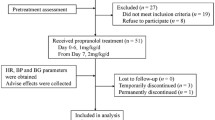Abstract
Propranolol is emerging as the treatment of choice for high-risk infantile haemangiomas. Current protocols recommend overnight admission for initiation of propranolol as well as baseline investigations including electrocardiography (ECG) and echocardiography (ECHO). Our study examined the safety profile of propranolol for the treatment of infantile haemangiomas using a simplified day-case initiation protocol. We evaluated 20 consecutive patients commencing propranolol as a day case for the treatment of an infantile haemangioma over an 18-month period. Investigations were carried out according to our local protocol. Cardiac investigations were not routinely performed. Patients were observed for 2 h following administration of the first dose of propranolol (0.5 mg/kg orally). If no adverse effects were observed, patients were discharged on a daily dose of propranolol of 1 mg/kg, increased to 2 mg/kg on day 4. Patients were reviewed on the day ward on day 8. All haemangiomas requiring treatment were small to moderate in size (median maximum diameter 2.35 cm). Except for capillary blood glucose measurement, no patient required venepuncture for additional blood investigations. As all patients had a normal clinical examination, none required ECHO. An ECG was performed on just one patient. No adverse reactions were observed following administration of propranolol. All patients were discharged home on the same day. No serious adverse events were reported at follow-up. We demonstrate that with targeted cardiac screening, propranolol can be safely initiated on a day-case basis for the treatment of small- to moderate-sized infantile haemangiomas.


Similar content being viewed by others
References
Belson MG, Sullivan K, Geller RJ (2001) Beta-adrenergic antagonist exposures in children. Vet Hum Toxicol 43:361–365
Bowers RE, Graham EA, Tomlinson KM (1960) The natural history of the strawberry nevus. Arch Dermatol 82:667–680. doi:10.1001/archderm.1960.01580050009002
Breur JM, de Graaf M, Breugeum CC et al (2011) Hypoglycemia as a result of propranolol during treatment of infantile hemangioma: a case report. Pediatr Dermatol 28:169–171. doi:10.1111/j.1525-1470.2010.01224.x
Chang LC, Haggstrom AN, Drolet BA et al (2008) Growth characteristics of infantile hemangiomas: implications for management. Pediatrics 122:360–367. doi:10.1542/peds.2007-2767
Drolet BA, Swanson EA, Frieden IJ et al (2008) Infantile hemangiomas: an emerging health issue linked to an increased rate of low birth weight infants. J Pediatr 153:712–715. doi:10.1016/j.jpeds.2008.05.043
Esterly NB (1995) Cutaneous hemangiomas, vascular stains and malformations, and associated syndromes. Curr Probl Dermatol 7(3):65–108. doi:10.1016/S1040-0486(09)80020-3
European Medicines Agency (1995) ICH Topic E 2 A. Clinical safety data management: definitions and standards for expedited reporting. http://www.emea.europa.eu/docs/en_GB/document_library/Scientific_guideline/2009/09/WC500002749.pdf
Gottschling S, Schneider G, Meyer S et al (2006) Two infants with life-threatening diffuse neonatal hemangiomatosis treated with cyclophosphamide. Pediatr Blood Cancer 46:239–242. doi:10.1002/pbc.20522
Haider KM, Plager DA, Neely DE et al (2010) Outpatient treatment of periocular infantile hemangiomas with oral propranolol. J AAPOS 14:251–256. doi:10.1016/j.jaapos.2010.05.002
Hogeling M, Adams S, Wargon O (2011) A randomized controlled trial of propranolol for infantile haemangiomas. Pediatrics 128:259–266. doi:10.1542/peds.2010-0029
Holland KE, Frieden IJ et al (2010) Hypoglycemia in children taking propranolol for the treatment of infantile hemangioma. Arch Dermatol 146(7):775–778. doi:10.1001/archdermatol.2010.158
Jacobs AH (1957) Strawberry hemangiomas: the natural history of the untreated lesion. Calif Med 86(1):8–10. doi:10.1097/00006534-195705000-00023
Kallen RJ, Mohler JH, Lin HL (1980) Hypoglycemia: a complication of treatment of hypertension with propranolol. Clin Pediatr 19:567–568. doi:10.1177/000992288001900814
Lawley LP, Siegfried E, Todd JL (2009) Propranolol treatment for hemangioma of infancy: risks and recommendations. Pediatr Dermatol 26:610–614. doi:10.1111/j.1525-1470.2009.00975.x
Léauté-Labrèze C, Dumas de la Roque E, Hubiche T et al (2008) Propranolol for severe hemangiomas of infancy. N Engl J Med 358:2649–2651. doi:10.1056/NEJMc0708819
Litovitz TL, Schmitz BF, Matyunas N (1987) Annual report of the American Association of Poison Control Centers National Data Collection System
Love JN, Howell JM, Klein-Schwartz W et al (2006) Lack of toxicity from pediatric beta-blocker exposures. Hum Exp Toxicol 25:341–346. doi:10.1191/0960327106ht632oa
Love JN, Sikka N (2004) Are 1–2 tablets dangerous? Beta-blocker exposure in toddlers. J Emerg Med 26:309–314. doi:10.1016/j.jemermed.2004.02.010
Manunza F, Syed S, Laguda B et al (2010) Propranolol for complicated infantile haemangiomas: a case series of 30 infants (letter). Br J Dermatol 162:466–468. doi:10.1111/j.1365-2133.2009.09597.x
Moroz B (1982) Long-term follow-up of hemangiomas in children. In: Williams HB (ed) Symposium on vascular malformations and melanotic lesions. Mosby, St. Louis, pp 27–35
Mulliken JB (1988) Diagnosis and natural history of hemangiomas. In: Mulliken JB, Young AE (eds) Vascular birthmarks: hemangiomas and malformations. Saunders, Philadelphia, pp 41–62
Park MK (2008) Pediatric cardiology for practitioners, 5th edn. Mosby, Philadelphia
Pavlakovic H, Kietz S, Lauerer P et al (2011) Hyperkalemia complicating propranolol treatment of an infantile hemangioma. Pediatrics 126:1589–1593
Sans V, de la Roque BJ et al (2009) Propranolol for severe infantile hemangiomas: follow-up report. Pediatrics 124:423–431. doi:10.1542/peds.2008-3458
Schiestl C, Neuhaus K, Zoller S et al (2011) Efficacy and safety of propranolol as first-line treatment for infantile hemangiomas. Eur J Pediatr 170:493–501. doi:10.1007/s00431-010-1324-2
Schupp CJ, Kleber JB, Günther P et al (2011) Propranolol therapy in 55 infants with infantile hemangioma: dosage, duration, adverse effects, and outcome. Pediatr Dermatol 28(6):640–644. doi:10.1111/j.1525-1470.2011.01569.x
Siegfried EC, Keenan WJ, Al-Jureidini S et al (2008) More on propranolol for hemangiomas of infancy. N Engl J Med 359:2846–2847
Truong MT, Perkins JA, Messner AH et al (2010) Propranolol for the treatment of airway hemangiomas: a case series and treatment algorithm. Int J Pediatr Otorhinolaryngol 74(9):1043–1048. doi:10.1016/j.ijporl.2010.06.001
Conflict of interest
None
Author information
Authors and Affiliations
Corresponding author
Rights and permissions
About this article
Cite this article
McSwiney, E., Murray, D. & Murphy, M. Propranolol therapy for cutaneous infantile haemangiomas initiated safely as a day-case procedure. Eur J Pediatr 173, 63–68 (2014). https://doi.org/10.1007/s00431-013-2105-5
Received:
Accepted:
Published:
Issue Date:
DOI: https://doi.org/10.1007/s00431-013-2105-5



